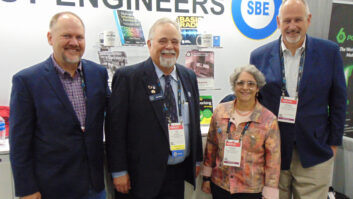William Hewlett and David Packard are among the newest members of the Consumer Electronics Hall of Fame. The CEA recently named 11 men to its class of 2005. Here are the bios, as provided by CEA:
• Ken Crane, known as the grand old man of retailing in southern California, started his first television business in 1948 and helped develop the concept of single-line retailing in the 1950s with Ken Crane’s Magnavox City. Currently, Ken Crane’s embraces the high-end of new technology and was among the first to sell HDTV and flat panel technology. His family currently operates Ken Crane’s stores in California.
• Joseph Donahue spent 43 years at RCA, starting as an engineer and rising to CEO. He invented the “slurry process” still in use today to produce picture tubes and oversaw the development of the Dimensia system, one of the first interconnected video products. In 1989 he began to focus on the development of the HDTV standard and was a leader in the Grand Alliance, which produced the HDTV standard adopted by the FCC.
• Harry Elias spent 37 years at JVC Company of America and built it into a $1.5 billion company with fewer than 300 employees. He is a past chairman of CEA’s Video Division and past member of CEA’s Board of Directors. In January 2005, he joined AKAI USA as chairman of the board and also serves on the Board of Directors for Bio-Reference Laboratories Inc.
• George Fezell implemented Magnavox’s innovative factory-direct business model in the 1950s and became president of the company’s consumer electronics division in 1968. A past member of the Electronics Industries Alliance’s Board of Governors, he was instrumental in the formation of the Consumer Electronics Division, the predecessor of CEA.
• Saul Gold served as the executive director of the North American Retailers Association for 30 years and was largely responsible for making the retailer buying group a respected force in the consumer electronics industry. Under his direction, regional retailers came together and competed on a national level with big box national retailers.
• Art Levis, a consumer electronics journalist and writer for more than 20 years, started reporting for Merchandising Week in 1968 and eventually became an editor at Consumer Electronics Monthly and the editor-in-chief of Video Magazine. He received numerous awards including the 1984 Jesse H. Neal Award for editorial achievement and the American Business Press Excellence Award in 1988. In 1991, he was posthumously inducted into the Video Hall of Fame for preeminent video journalism.
• Jack Luskin, a Baltimore/Washington/Virginia area retailer for nearly 50 years, opened his first store in 1948 becoming one of the nation’s first TV dealers. He has spent 15 years as the commissioner of the Maryland Public Broadcasting Commission and was the vice president of NATM, the retail buying group.
• Masaharu Matsushita joined Matsushita Electric Industrial Co. Ltd. as an auditor in 1940 and steadily moved up the ranks to president then chairman of the board. Under his leadership, the company, best known for its Panasonic Brand, became the largest consumer electronics company in the world.
• William Hewlett and David Packard, the fathers of Silicon Valley, launched what is now the world’s largest personal computer company from a California garage in 1939. Aside from HP, Packard served as U.S. Deputy Secretary of Defense from 1969-71 and was a co-founder and past chairman of the American Electronics Association. Hewlett was awarded the National Medal of Science, the nation’s highest scientific honor in 1983.
• John Winegard, an inventor and entrepreneur who developed the rooftop television antenna, incorporated the Winegard Company in 1953. Winegard became the prototype for consumer electronics accessory businesses and is still a major supplier of K-band antennas and mobile satellite systems worldwide. During his life, Winegard was granted 28 patents and designed communications amplifiers for NASA for which he was recognized for his contribution to the Apollo space missions.












